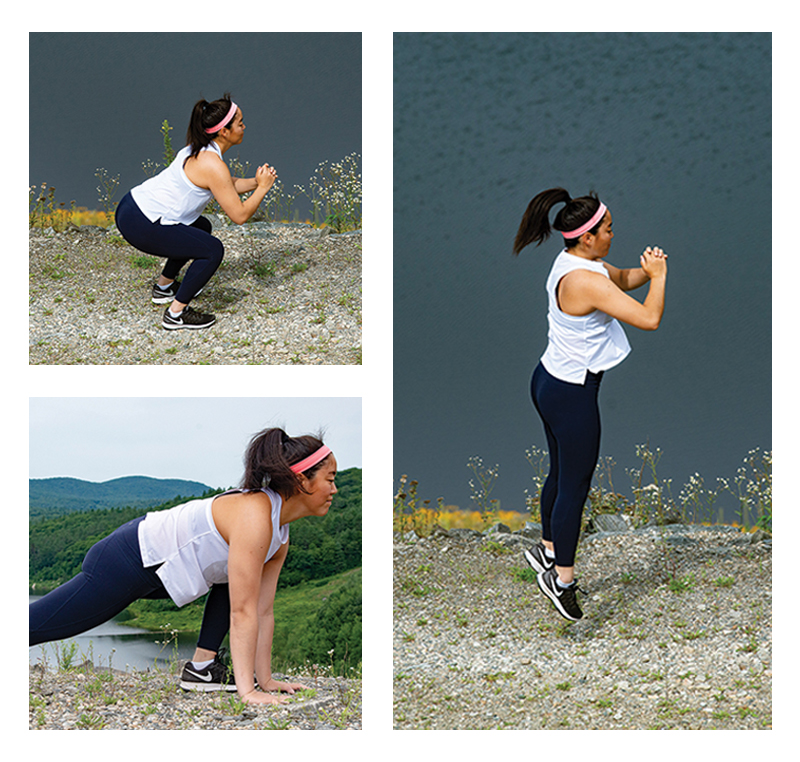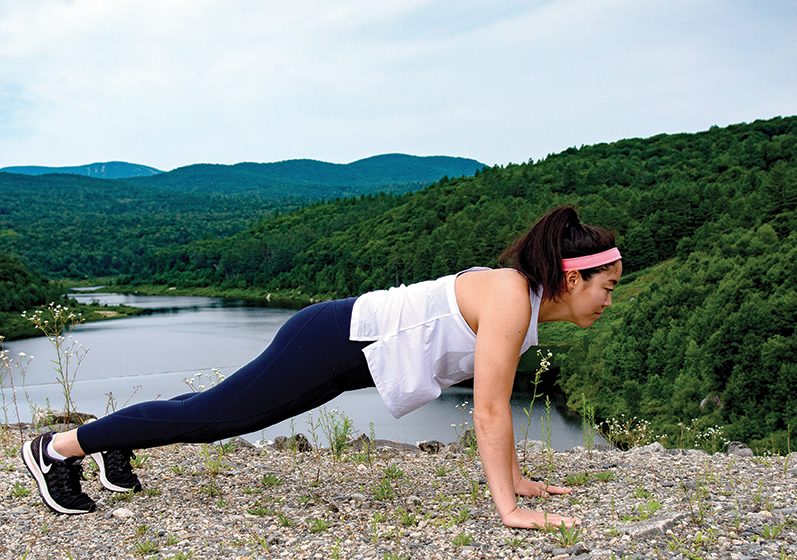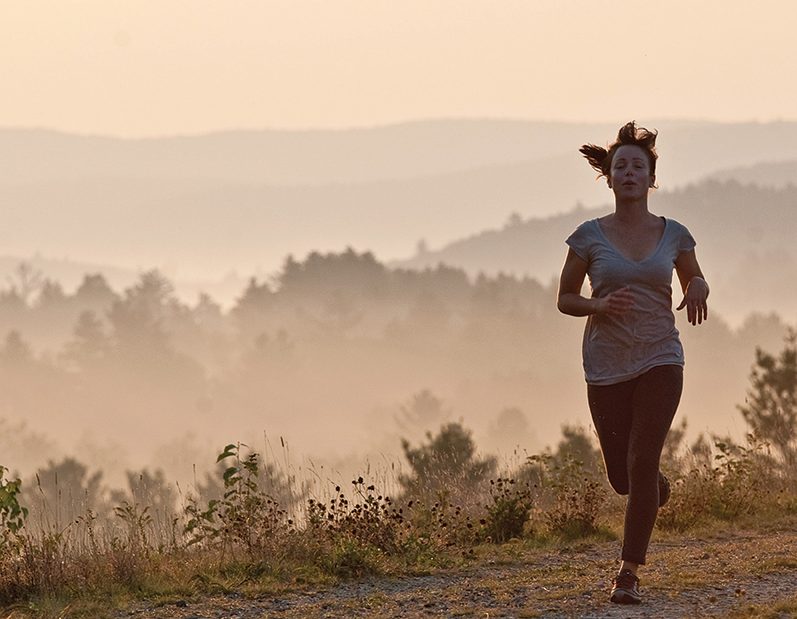The best way to be ready to go when the first snow falls is to stay fit all year ’round.
By Gayle Fee
Photography by Hubert Schriebl
Winter is coming. Your skis or board are waxed, your bindings are tuned, and your boots are broken in; but is your body ready to hit the slopes? If you’ve been lying by the pool sipping piña coladas all summer, that would be a no. Even if you managed to stay somewhat active, you may not be up for those leg-burning double blacks right out of the gate. The good news is, you’ve still got a couple of months to get ready to ski and ride without getting the dreaded early-season “rubber legs.”
“Skiing, riding, and cross-country skiing are strength and endurance sports that use the whole body and the fitter you are, the more you enjoy it,” said Stratton Mountain School’s Nordic program director, Sverre Caldwell. “When you’re in shape you can go farther and faster and that’s more fun.”
Of course, the best way to be ready to go when the first snow falls is to stay fit all year ’round, said David Edry, alpine program director for Stratton Mountain Winter Sports Clubs.
“If you take six or eight months off, it’s going to take you longer to get back into shape,” he said. “And the older you get, the longer it takes.”
The good news is, you can build up your leg strength, improve your balance and coordination, and achieve better all-around fitness by tackling a pre-season exercise routine three or four times a week. Start now, and by the time the first snow flies, you’ll be ready to ski or ride harder and longer while reducing your chances of suffering an injury caused by weakness or fatigue. Step one is to get up off the couch and get outdoors.
“You want to have a good base of endurance. That means aerobic training,” Caldwell said. “Go outside and do some different things. Go for runs, hikes, or biking, things like that. You want to build a base of fitness.”
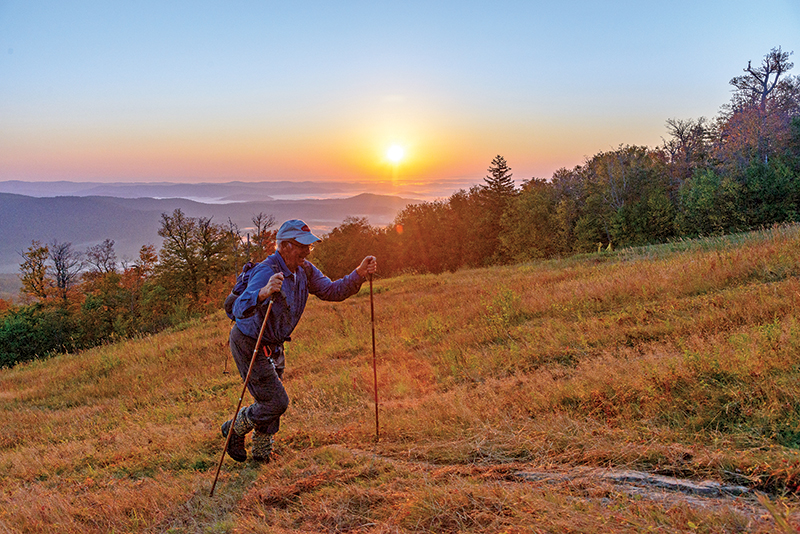
No one is a better example of the benefits of staying in shape year-round than Stratton’s living legend, mountain photographer Hubert Schriebl. Here he is on a hike up Stratton Mountain.
Building endurance improves your muscles’ ability to function as you carve your way down a long winding slope. To get technical, aerobic exercise helps your body break down the buildup of lactic acid in the muscles that is responsible for the burning thigh sensation you get mid-run. Caldwell suggests doing enough aerobically to get your heart rate above 120 for an extended period of time—and by that he means for more than an hour.
“If you haven’t done anything for a while, you need to work up to that,” he added. “Do something you like to do. Hiking may be the easiest; you can hike somewhere fun and there’s no pounding on your muscles as you build leg strength. If you love biking, great. Do what you can do comfortably at first, and add a little each week. Do it three times a week and in four to eight weeks you should be in pretty good shape.”
Edry encourages his athletes to participate in other sports during the off-season to get their aerobic workouts and to stay in shape for winter. “Tennis is one of the best sports you can play for balance and coordination,” he said. “Soccer is also wonderful for general fitness.”
Yoga is great for stretching and balancing, and while golf is a great outdoor sport in the warm weather, it has limited benefits as a crossover for winter sports, Edry warns. Both coaches also recommend incorporating strength training into your fitness regime, but that doesn’t mean hitting the gym and doing dozens of leg presses.
“That’s not necessarily the best use of your time,” Edry said. “You can do a half hour or 45 minutes of squats, but then you’ve only worked one muscle group. You’re not getting the full requirement of work needed to ski and snowboard.”
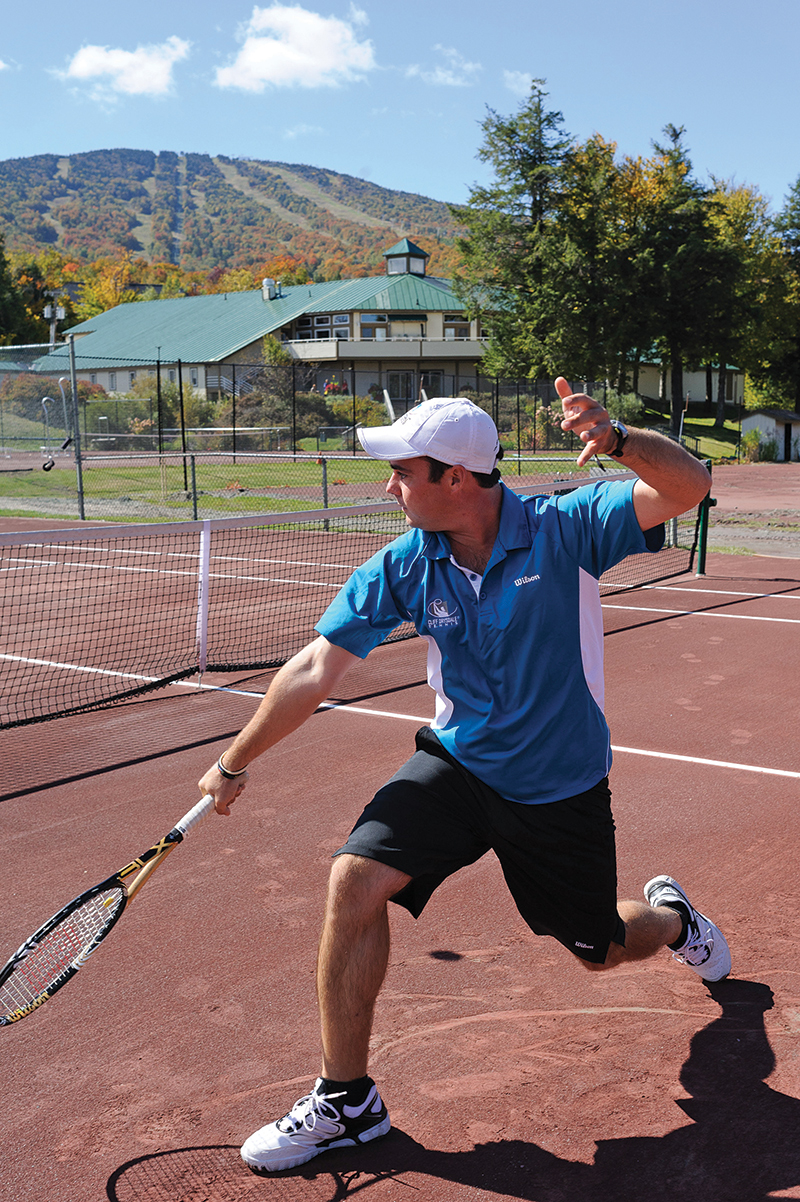
“Tennis is one of the best sports you can play for balance and coordination.”
– David Edry, alpine program director for Stratton Mountain Winter Sports Clubs
Edry, a big fan of all-body fitness regimes, has devised a workout plan for his athletes that targets all areas of fitness, unlike machine-based gyms that work just one muscle group at a time. “Agility, coordination, cardio, general strength, and core strength are all addressed,” he said. “And 90 percent of these workouts are done without equipment and can be done anywhere. No gym necessary!”
He recommends starting with a light aerobic activity such as a short run, followed by some stretching and then a few sets of burpees. “It’s one of those exercises everyone hates, but everyone does,” he laughed. “They’re very taxing and they shoot your heart rate up really fast.”
To do a burpee (also known as a squat thrust), start in a standing position, feet shoulder-width apart and weight in your heels and arms at your side. Push your hips back, bend your knees, and lower your body into a squat. Place your hands on the floor directly in front of, and just inside, your feet, then shift your weight onto them. Jump your feet back to softly land on the balls of your feet in a plank position. Now jump your feet forward toward your hands, reach your arms over your head, and jump up into the air. As you land, immediately lower back into a squat for your next rep.
“Burpees are a great all-body workout that hits multiple muscle groups at the same time,” Edry said. Follow the sets of burpees with sets of push-ups, pull-ups, sit-ups, squats, or box jumps. Mix them up, doing different exercises each day so you don’t get bored.
Edry’s young athletes do sets of 40, 30, 20, then 10 of each exercise, but he stresses that the workouts can and should be scaled down if your base fitness is lower or you’re an older adult. Listen to your body and don’t do anything to hurt or over-exert yourself. Follow up the strength exercises with another light aerobic activity, some stretching, and you’re done. Do this for an hour three or four times a week and Edry says you’ll be ready to shred come winter. But besides looking good on the slopes, the other big reason to get your body ready before ski season is injury prevention.
“When you’re skiing or riding you’re pretty much unbalanced all the time,” Edry said. “It’s easy to create a situation where you can hurt yourself. But the stronger you are, the less chance of that happening.” Couch potatoes are far less likely to recover from possible falls, which can lead to muscle tears and ACL injuries.
“If you’re not trained, you are going to get fatigued easier and you’re far more apt to make a mistake,” Caldwell said. “When your muscles can’t keep you balanced or controlled you’re far more likely to blow out and fall down.”
And finally, one of the best reasons to get in shape is pure economics. You want to make the most of every day on the slopes and not have to quit after just three early-season runs because your legs are sore! “You want to get your money’s worth,” Caldwell pointed out, “so you’ve got to hurt less. So set a routine and get to it.”
Because, as all Game of Thrones fans will tell you: Winter Is Coming!
Get Down, Get Up
Burpees, aerobic exercises that work your arms, back, chest, core, glutes, and legs, are the best way to get in shape for skiing and riding.
Here’s how to do them: From a standing position, drop into a squat with your hands on the ground just in front of your feet.
Then kick your feet back behind you, keeping your arms extended so you are in a raised plank position.
Feeling adventurous? Throw a push-up into the mix here or skip to the next step. From the raised plank, jump your feet back up toward your hands.
Finish by leaping into the air with your arms straight above you. Then do it all again. And again…
